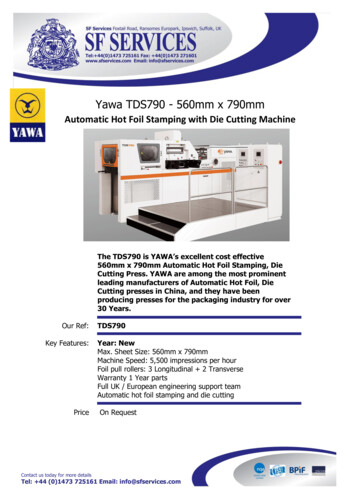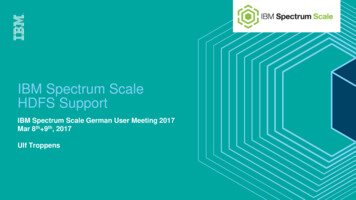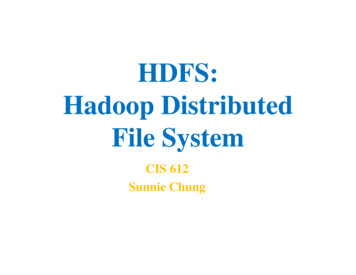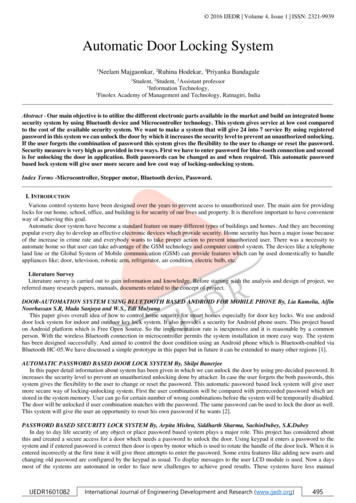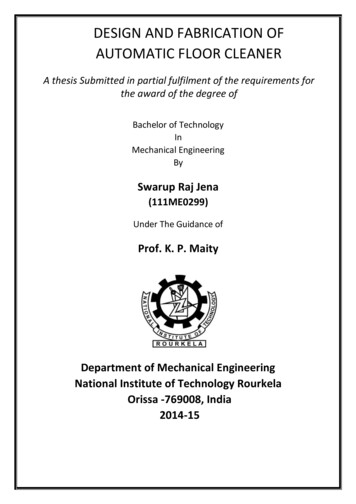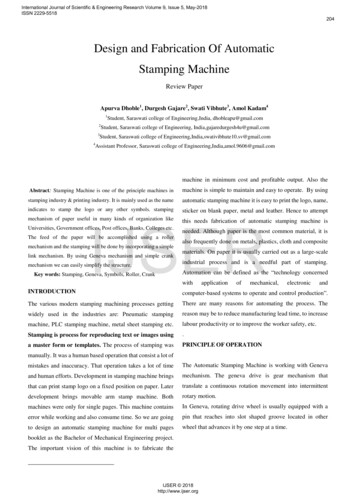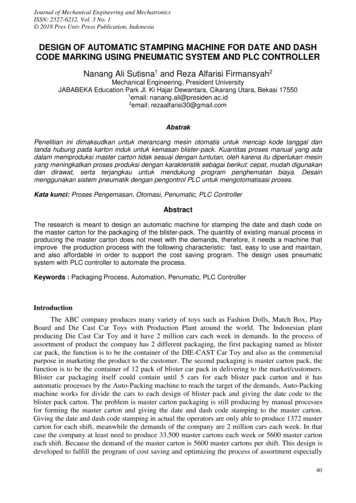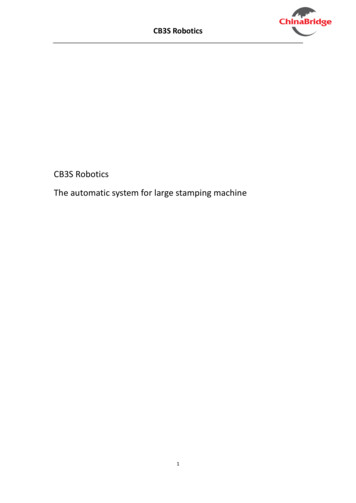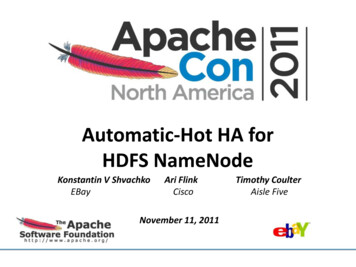
Transcription
Automatic-Hot HA forHDFS NameNodeKonstantin V ShvachkoEBayAri FlinkCiscoNovember 11, 2011Timothy CoulterAisle Five
About Authors Konstantin Shvachko– Hadoop Architect, eBay;Hadoop Committer Ari Flink– Operations Architect, Cisco Tim Coulter– Cloud Architect, Aisle Five Consulting Thanks to Rajesh Balasa2
Agenda What is HA– Why HA is important for Hadoop– And why it is not HDFS architecture principles– How HDFS HA is different from traditional HA design choicesOne simple design: Details in HDFS-2064ComparisonsHadoop 0.22 progress3
Why High Availability is Important? Nothing is perfect:– Applications and servers crash– Avoid downtime Conventional for traditional DB andenterprise storage systems Industry standard requirement4
And Why it is Not? Scheduled downtime dominates Unscheduled– OS maintenance– Configuration changes Other reasons for Unscheduled Downtime– Full GC– System bugs: HDFS and the stack above Pretty reliable5
How Reliable is HDFS Today?From Hadoop World Presentation By Sanjay, Suresh, Aaron Internet industry HA standard 99.94% (5.26 h/y)6
Fable Need to eliminate SPOF– Enterprise storage standard Minimize the effort– No immediate business impact7
Hadoop Cluster Components HDFS – a distributed file system– NameNode – namespace and block management– DataNodes – block replica container MapReduce – a framework for distributed computations– JobTracker – job scheduling, resource management, lifecyclecoordination– TaskTracker – task execution kTrackerDataNodeDataNodeDataNode8
HDFS Overview The namespace is a hierarchy of files and directories Files are divided into data blocks (typically 128 MB) Namespace (metadata) is decoupled from data– Fast namespace operations– not slowed down by Data streaming Single NameNode keeps the entire name space in RAM DataNodes store block replicas as files on local drives Blocks are replicated on three DataNodes– for redundancy and availability9
NameNode Transient StateNameNode RAMapps/HierarchicalNamespacehbasehiveusersshvblk 123 001dn-1dn-2dn-3blk 234 002dn-11dn-12dn-13blk 345 003dn-101dn-102dn-103dn-1 Heartbeat Disk Used Disk Free xCeiversdn-2 Heartbeat Disk Used Disk Free xCeiversdn-3 Heartbeat Disk Used Disk Free xCeivers10Block ManagerLiveDataNodes
NameNode Persistent State The durability of the name space is maintained by awrite-ahead journal and checkpoints– Journal transactions are persisted into edits file beforereplying to the client– Checkpoints are periodically written to fsimage fileHandled by Checkpointer– Block locations discovered from DataNodes during startupvia block reports. Not persisted on NameNode Types of persistent storage devices– Local hard drive– Remote drive or NFS filer– BackupNode11
DataNodes DataNodes inform NameNode about itself– Heartbeats (3 sec)– Block reports (1 hour)– Replica received NameNode replies to DNs with control commands– Delete block replica– Replicate block to another DataNode– Re-register, send emergency block report, shutdown, etc.12
NameNode HA Challenge Naïve Approach– Start new NameNode on the spare host, when theprimary NameNode dies:– Use LinuxHA or VCS Not NameNode startup may take up to 1 hour– Read the Namespace image and the Journal edits– Wait for block reports from DataNodes (SafeMode).13
BackupNode BackupNode ( 0.21) is a read-only NameNode–––––––Holds namespace in sync with NameNodeWorks as a persistent storage device for NameNodePerforms periodic checkpointsCan perform namespace read requests, as lsDoes not know replica locationsRejects namespace modification requests, as mkdirCannot take over in case of NameNode failure14
Failover Classification Manual-Cold (or no-HA) – an operator manually shuts down andrestarts the cluster when the active NameNode fails. Automatic-Cold – save the namespace image and the journal into ashared storage device, and use standard HA software for failover.It can take up to an hour to restart the NameNode. Manual-Hot – the entire file system metadata is fully synchronizedon both active and standby nodes, operator manually issues acommand to failover to the standby node when active fails. Automatic-Hot – the real HA, provides fast and completelyautomated failover to the hot standby. Warm HA – BackupNode maintains up to date namespace fullysynchronized with the active NameNode. BN rediscovers locationfrom DataNode block reports during failover. May take 20-30minutes.15
HA: State of the Art Manual failover is a routine maintenance procedure:Hadoop Wiki Automatic-Cold HA first implemented at ContextWebuses DRBD for mirroring local disk drives between twonodes and Linux-HA as the failover engine AvatarNode from Facebook - a manual-hot HA solution.Use for planned NameNode software upgrades withoutdown time Five proprietary installations running hot HA Designs:– HDFS-1623. High Availability Framework for HDFS NN– HDFS-2064. Warm HA NameNode going Hot– HDFS-2124. NameNode HA using BackupNode as Hot Standby16
Terminology NameNode – active NN, serving clientrequests BackupNode – keeps the up-to-date image ofthe namespace; available for read-only access StandbyNode (SBN) – has all the functionalityof the BackupNode, plus it can change its roleto active via the failover command17
HA: Design Choices1. Keep StandbyNode namespace up to date2. Up to date block replica locations3. Coordination service / Failover tool18
Simple Design for Automatic-Hot HA Minimalistic approach to eliminate SPOF for HDFS Leverage the power of trusted HA software– People dedicate their lives to building HA software– Hadoop should utilize the results and build on top Separate HA handling issues from HDFS-specific ones– Hadoop developers focus and optimize for the latter Minimize code changes– No code – No bugs, No code maintenance Minimize the number of distributed components– Less components - reduce coordination complexity19
Automatic-Hot HA – Design Principles Standard HA software– LinuxHA, VCS, Keepalived StandbyNode – a BN that can become active NN LoadReplicator – a highly available cluster component– LoadReplicator is a proxy layer between DataNodes and Name- /Standby- Nodes– Zeus Load Balancer Riverbed Traffic Manager VIPs are assigned to the cluster nodes by their role:– NameNode – nn.vip.host.com– LoadReplicator – lr.vip.host.com– StandbyNode – sbn.vip.host.com IP-failover20
HDFS omHDFS editstreamfsimagecheckpointsStandbyNodeSpare Nodesbn.vip.host.comfs.default.name configured asa VIP in a LoadReplicator.LoadReplicator mirrorsDataNode requests toStandbyNodeDataNode sends:1) Heartbeat: every 3 sec2) Block report: hourlyfs.default.namelr.vip.host.comDataNodes21
HDFS .comHDFS NodeHDFS editstreamfsimagesbn.vip.host.com checkpointsnn.vip.host.comSpare Nodesbn.vip.host.comStanbyNode has fsimage andBring up spare system in theblock reports already incluster as the newmemory, switch it into activeStandbyNodeNameNode modefs.default.namelr.vip.host.comDataNodes22
Load Replicator LoadReplicator is a new highly available component of the cluster,which acts as a proxy layer between DataNodes and NN – SBN pair LR is the new target for DataNode messages For each received message LR forwards it to NN and SBN LR obtains a response from the active NN and forwards it to the DN LR ignores any responses from SBN LoadReplicator runs on two or more physical nodes– Uses commodity hardware LR is highly available. When one of LR nodes fails the incoming loadis seamlessly redistributed between the remaining nodes Introduction of LoadReplicator is justified by– Hadoop code changes are isolated to the StandbyNode only– Changes to NameNode, DataNode and HDFS client are negligible Can be replaced with Local LoadReplicators running on each DN23
Failover Command hadoop dfsadmin –failover [nnVIP] Used for manual and auto failover1. Verify that SBN owns passed nnVIP address2. If nnVIP NULL, then the verification is not performed.3. Try to shutdown the NameNode gracefully by sending resign() request via regular RPC port HTTP servlet service RPC port4. If checkpoint is in progress, then stop the process, and prevent fromstarting a new checkpoint.5. Stop the RPC client talking to the NameNode6. Digest journal spool if checkpoint was in progress. IncrementcheckpointTime to make it the latest image7. Stop the Checkpoint Manager8. Change role to active9. Reset SafeMode extension to the configured value10.Reset lease hard limit to the default24
ComparisonThis approachHDFS-2064Shared storageHDFS-1623NamespaceSynchronizationReal-time Journal Streamingto StandbyNodeShared storage NFS Filer60 sec delayedBlock LocationsLoadReplicatorDataNodes distinguishbetween Active NN and SBNFailoverIP failoverLinuxHA, VCS, keepalivedZookeeper coordinatingClients, DataNodes, etc.Code Changes SBN extension of BN Admin “failover” command NN health monitor All from left Plus Clients talking to ZK, NN DNs talking to NN, SBN, ZK Failover25
Disadvantages of Shared StorageSynchronization Shared storage design requires investment inNFS Filer– 20K - 100K– Buy 10 - 20 more nodes instead Dependency on Enterprise Hardwarefor Hadoop commodity hardware clusters Hot HA, except 60 sec delay26
Project Status Detailed design attached to HDFS-2064– Reviewed Patch for 0.22 is available– Will keep up to date Proof of concept demo– Keepalived– Trial version of Zeus– Configuration verified Just get HA done. Scalability is the biggest problem– Dynamic namespace partitioning with distributed NN– Federation provides static partitioning only27
Thank You!28
Hadoop 0.22 Branch created 11/17/2010 Testing of new and existing features– Append by HBase community– Different groups in Hadoop community RM from August––––Testing team at eBay and many other peopleGood testing results. ReliableBugs found in 0.22 are also in trunkBigTop builds 0.22 Community release: Important– Works but not 0.20. Good new features. Missing parts– 0.22.1 add Security, Disk Fail in place, MR task limits,optimizations, metrics 2.Add HA?29
–Zeus Load Balancer Riverbed Traffic Manager . Load Replicator LoadReplicator is a new highly available component of the cluster, which acts as a proxy layer between DataNodes and N

